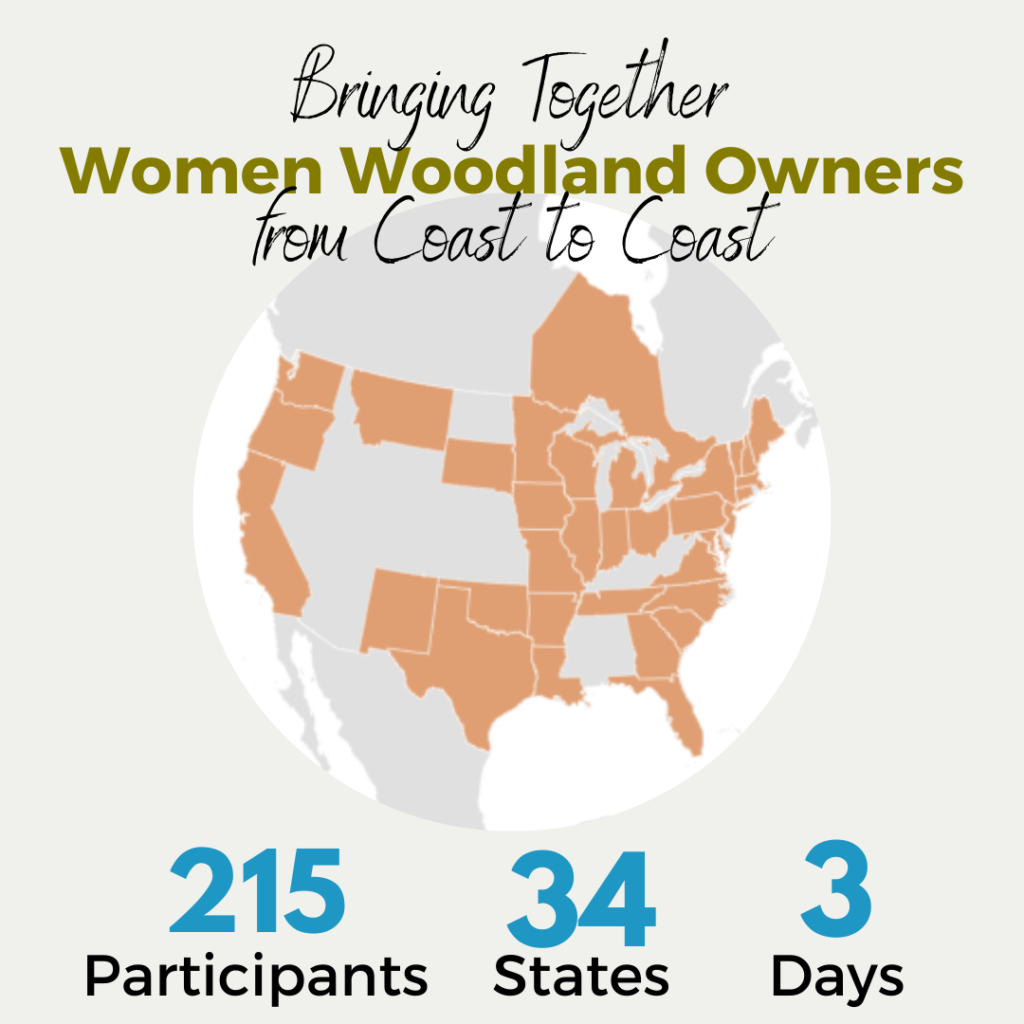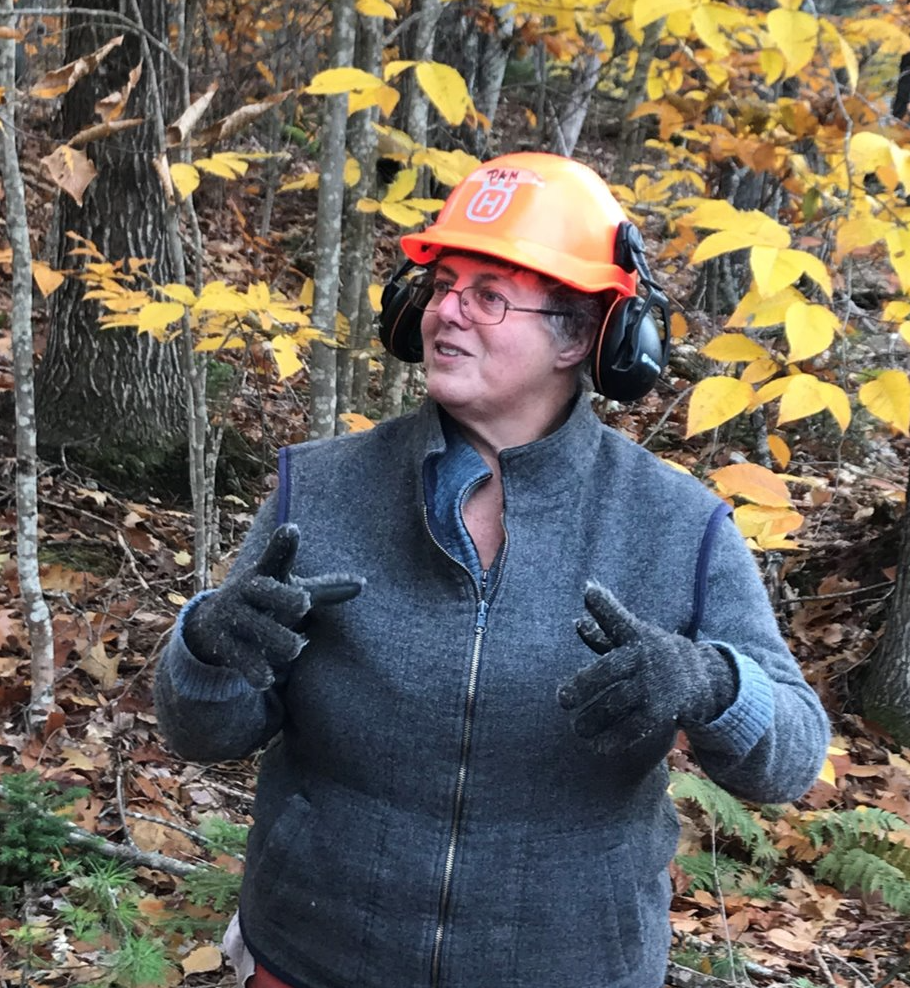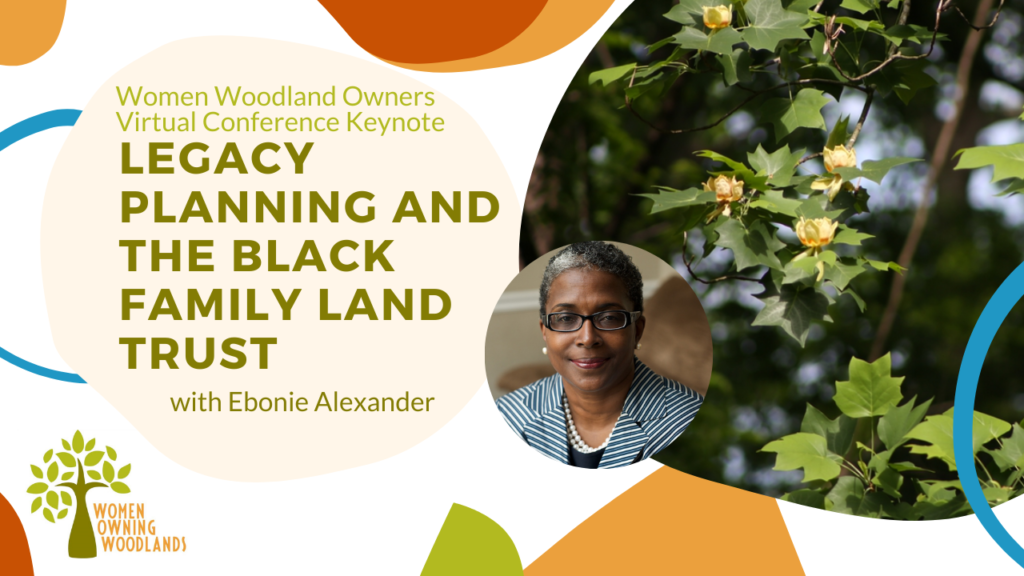The Women Owning Woodlands Conference in Review: March 2022

This map shows where 215 participants gathered from, over 3 days, and across 34 states and provinces in the U.S. and Canada.
Written by Maddie Eberly
Eager to learn from natural resource professionals while sharing stories and plans from their own lands, 215 participants gathered for the Women Owning Woodlands Conference in early March.
The conference began on a lively note with a presentation about Pam Wells, Maine Tree Farmer and popular women’s chainsaw safety instructor, highlighting her story as a woodland owner and of her path to forestry. When she and her husband bought their woodlands, like so many others, Pam realized she needed to learn how to be a steward and take care of the land. She learned from her forester how to get started on writing management plans, and then reenrolled in forestry courses. Wells actively harvests on her land while managing for wildlife and has become a great resource to landowners, forestry students, and others.
During Pam’s presentation, participants flooded the chat with questions and story sharing. Conference attendees were then given the option of choosing a breakout room focused on topics such as “Wildlife in Your Woods,” “Invasive Species,” and “The Fire Within Us.” The meeting closed with a thoughtful reflection on the presentations heard and how they impacted those in attendance.

Pam Wells giving a talk on women’s chainsaw safety.
“This group has passion, an awesome comradery of women in conservation!” – Kristie in Pennsylvania
“I so appreciate this conference, empowering women to care for the land. …I reflect on my grandfather being a lumberman in Maine 100 years ago to the possibility of passing down our woods in MN to our daughters in the future.” – Julie in Minnesota
The second day brought many more knowledgeable, fabulous presenters. Ebonie Alexander, Executive Director from the Black Family Land Trust (BFLT), presented on legacy planning and her work with the BFLT. She had a robust career in the natural resources. Alexander inherited land in Virginia, where she lives today. In her keynote speech, she stated, “With every generation that you own your land, you should make the land human. I have stories about every generation that we can go back to on this land…. What they did, how they reacted, and how they lived.” Remember that spot where your sibling climbed that gigantic tree? Or the place where your parent would sit each evening soaking in the sun and listening to the evening sounds? Alexander emphasized this connection to land while telling her story and uplifted the possibility of keeping land within a family for generations to come. BFLT has worked with landowners committed to keeping land in their families. Alexander has helped lead the way to land retention and protection for many families over the years and continues to help people who want to make their land more human. After Ebonie’s presentation, conference participants had the chance to connect through small group discussions, hearing each other’s stories and connecting through stories of the land.

Ebony Alexander’s presentation on “Legacy Planning and the Black Family Land Trust.”
“My daughter learned to walk at our cabin in the woods.” – Stacey in Minnesota
“Our woodlands help provide a wonderful place to spend time reflecting and becoming more grounded.” WOWConference_article – Ingrid in Wisconsin
“I’m a singer/song writer and enjoyed writing and producing children’s songs about our land, while spending time on the land when my boys were little!” – Sara in Maine
Following these discussions, a “Questions & Answers” session with knowledgeable women professionals allowed participants the opportunity to have their questions answered on a variety of topics including management planning, climate change, invasive species, non-timber products, forest pests, wildfire and prescribed fire, and timber harvests. Once again, the day closed in reflection.
On the third and final day of gathering, participants were given the opportunity to attend two sessions of their choice to grow and develop skills to steward their land. The sessions included “Chainsaw Personal Protective Equipment for Women,” “Forest Products Beyond Timber,” “Wildlife and Working Forests,” “Tree Syruping and Mushroom Cultivation,” “Setting Goals for My Land,” and “Adapting Homes and Communities to Wildfire.” The presenters each held immense expertise in their topics and gladly welcomed the questions and discussions brought by participants. Following these sessions, everyone reconvened and reflected on what was learned and what will be done. Participants were asked to set two goals for themselves, one short-term and one long-term, that would guide them in the care of their land and connection to it.
“Short term: comprehensive walkthrough of the property with my family and inventory. Long term: working with county forester to create a plan” – Sharon in Wisconsin
“Short and long term: spend more time” – Hoi Ning in Maine
“Short term: complete thinning operation and long term: open and maintain 2-4 miles of preexisting trails” – Patricia in Washington
Watch Ebonie Alexander’s full presentation on the Forest Stewards Guild’s YouTube channel.
“‘Off to the woods, now’. Full of inspiration!” – Kathleen in Minnesota
